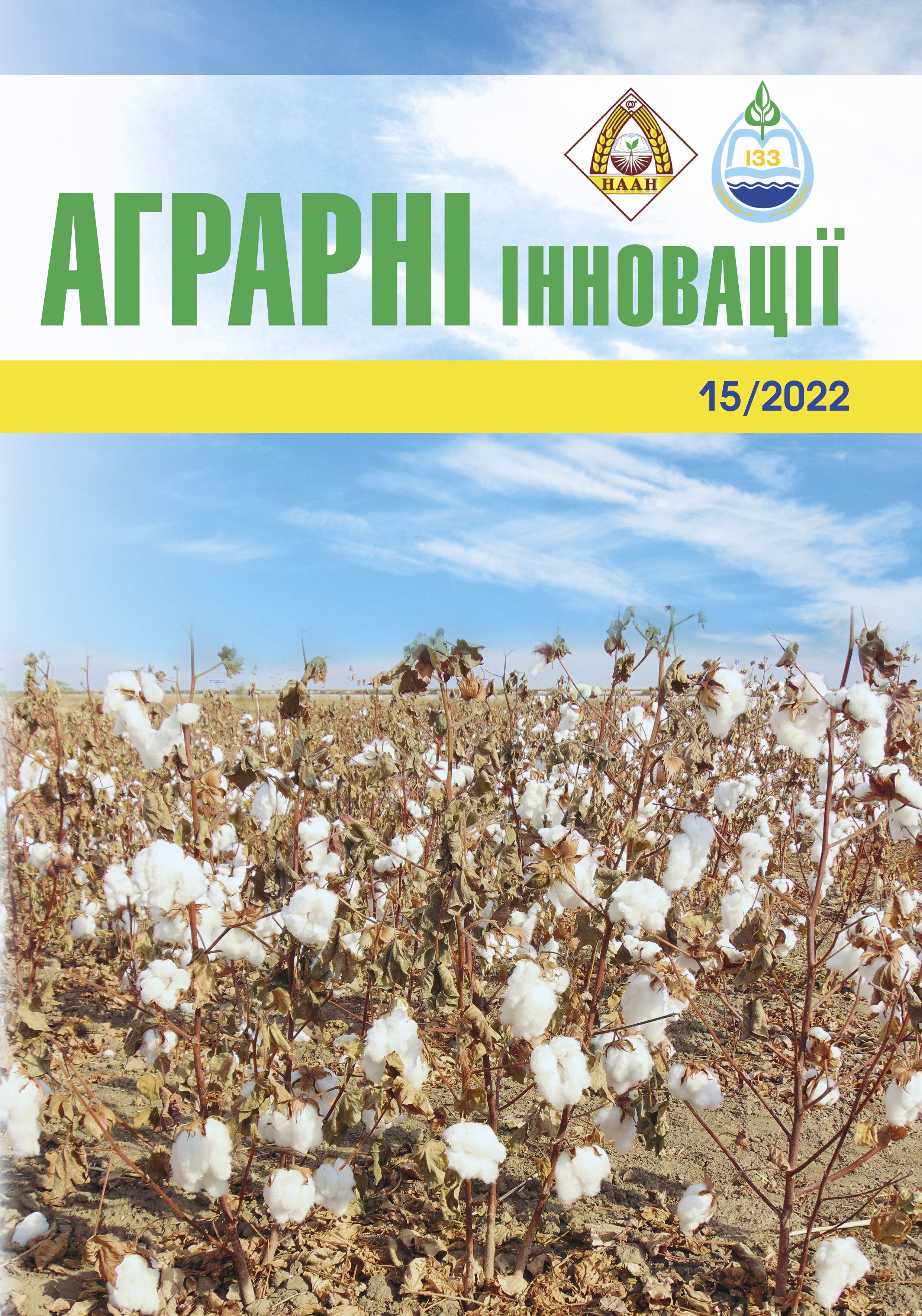Depressive effects of nitrosoalkylureas at the winter wheat first generation
Abstract
The general trend is the genetic improvement of winter wheat, one of the variants of which is induced biodiversity through the use of appropriate mutagenic factors. Purpose. The aim was to identify possible depressive effects when using mutagens of the nitrosoalkylureas group in the first generation of plants of soft winter wheat varieties based on indicators of germination, survival, fertility, and yield structure in order to determine the optimal processing protocol in view of obtaining the necessary amount of material for further research. Methods: Seeds 8 winter wheat varieties of Balaton, Borovytsia, Zeleny Gai, Zoloto Ukrainy, Kalancha, Niva Odeska, Polyanka, Pochayna were treated with a solution of the chemical mutagen NEU in concentrations of 0.01 and 0.025%, NMU in concentrations of 0.0125 and 0.025%. Germination, survival, and fertility of pollen grains were evaluated in the M1 generation, and the parameters of the yield structure were analyzed. Results. It was established that the action of NEU was less harmful than the action of NMU. Quite often, for most samples, 0.025% HEU action corresponded to 0.0125% NMU concentration. With NEU, remote mortality was much less likely, while NMU was characterized by high mortality during overwintering. Mutagens have less influence on the fertility of the studied genotypes than they have on survival. It is more uniform with regard to individual genotypes, NMU increased the sterility of the obtained material more than HEU. Among the parameters of the structure based on the reproduction of mutagenic depression, the most reliable plant height and TGW stood out. The sign of the number of grains from an ear almost does not vary. Signs weight of grain from the main ear and weight of grain from the plant as a whole vary in accordance with the increase in concentrations as a whole, but sometimes their reaction differs within a separate genotype. Findings. The action of nitrosoalkylureas did not lead to a critical or even semlethal decrease in ontogenesis indicators in first-generation plants, so the applied concentrations should be considered acceptable for practical use. In terms of its damaging ability, nitrosoethylurea is significantly inferior to nitrosomethylurea. Indicators of germination, survival, fertility, plant height and weight of one thousand grains turned out to be model for detecting mutagenicity, but the genotype-mutagenic specificity decreased significantly.
References
2. Cann D., Hunt J., Rattey A., Porker K. (2022). Indirect early generation selection for yield in winter wheat. Field Crops Research, 282, 108505. doi: 10.1016/j.fcr.2022.108505
3. Mamenko Т. P., Yakymchuk R. A. (2019). Regulation of physiological processes in winter wheat by growth regulators in conditions of powdery mildew infection. Regulatory Mechanisms in Biosystems, 10(3), 331–336. doi: 10.15421/021951
4. Mangi N., Baloch A., Khaskheli N., Ali M., Afzal W. (2021). Multivariate Analysis for Evaluation of Mutant Bread Wheat Lines Using Metric Traits. Integrative Plant Sciences, 1(1), 29–34. https://doi.org/10.52878/ipsci.2021.1.1.4
5. Nazarenko M. (2016). Identification and characterization of mutants induced by gamma radiation in winter wheat (Triticum aestivum L.). Scientific Papers. Series A. Agronomy, LIX, 350–353.
6. Nazarenko M., Gorschar V., Lykholat Yu., Kovalenko I. (2020). Winter wheat mutations by plant height and structure caused by chemical supermutagens. Scientific Papers. Series A. Agronomy, LXIII(1), 443–449.
7. Shu Q.Y., Forster B.P., Nakagava H., Plant mutation breeding and biotechnology. CABI publishing, Vienna, 2013. Р. 611.
8. Spencer-Lopes M.M., Forster B.P., Jankuloski L. Manual on mutation breeding. Third edition. Food and Agriculture Organization of the United Nations, Rome. 2018. Р. 672.
9. Yali W., Mitiku T. (2022). Mutation Breeding and Its Importance in Modern Plant Breeding. Journal of Plant Sciences, 10(2), 64–70. doi: 10.11648/j.jps.20221002.13
10. Yakymchuk R. А., Valyuk V. F., Sobolenko, L. Y., Sorokina S. І. (2021). Induction of useful mutations in Triticum aestivum in the conditions of the radionuclidecontaminated alienation zone of the Chornobyl Power Plant. Regulatory Mechanisms in Biosystems, 12(3), 506–512. doi:10.15421/022169
11. Xicun D., Xia Y., Wenjian L. (2016). Plant Mutation Breeding with Heavy Ion Irradiation at IMP. Journal of Agricultural Science, 8(5), 34–41. doi: 10.5539/jas.v8n5p34






